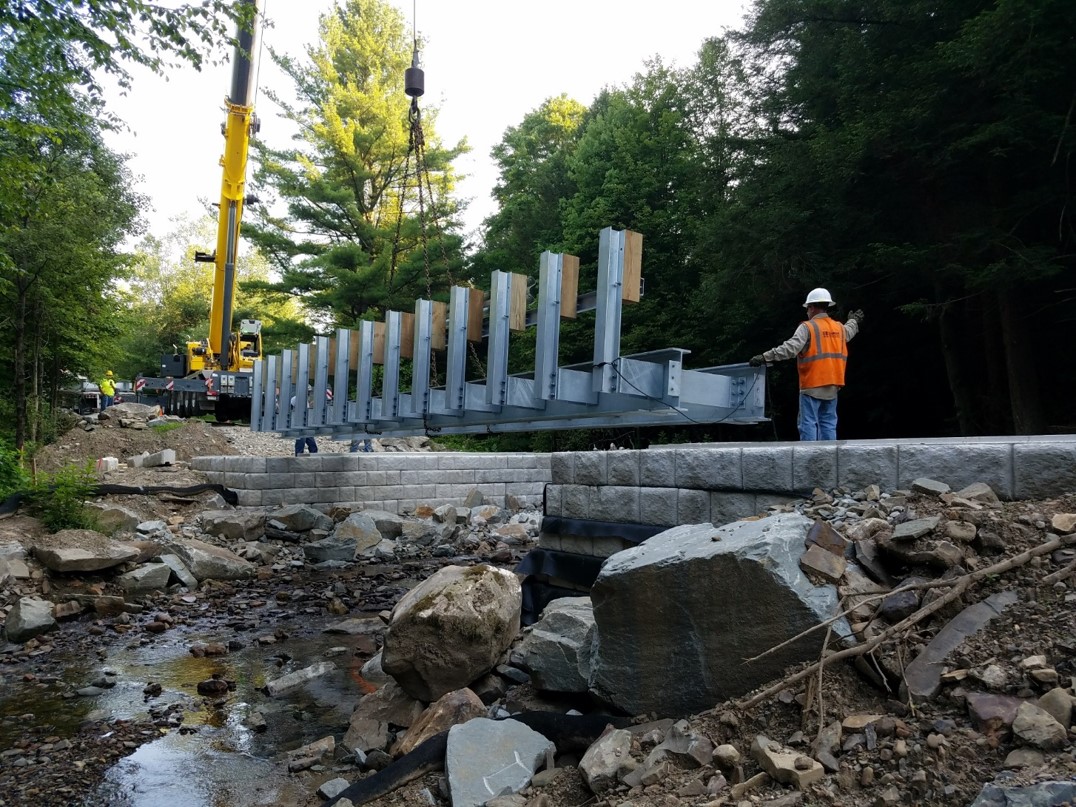Geosynthetic Reinforced Soil – Integrated Bridge Systems
Geosynthetic Reinforced Soil – Integrated Bridge Systems (GRS-IBS), an
Accelerated Bridge Construction method, allows PennDOT, the Pennsylvania Turnpike Commission and local municipalities to build bridges quickly and cost effectively, using local workforce personnel and equipment to maximize efficiency. GRS-IBS is a
Federal Highway Administration (FHWA) Every Day Counts Round 1 and Every Day Counts Round 3 (EDC-1 and EDC-3) innovation that Pennsylvania championed.
How Does It Work?
The technology consists of three main components: the reinforced soil foundation, the abutment, and the integrated approach roadway. GRS uses alternating layers of geotextile material combined with crushed and graded stone and concrete facing blocks to construct the bridge abutments. The closely spaced reinforcement layers and granular soil create an efficient composite material that is internally stable and capable of carrying bridge loads significantly higher than designed with predictable and reliable performance. The IBS is created when the superstructure (typically beams and deck) is placed on top of the GRS abutments to create the bridge. The alternating soil-geotextile layers continue as the approach backfill to make a smooth transition from the approach roadway to the deck without joints, deep foundations, approach slabs, or waiting for cast-in-place concrete to cure and effectively eliminate the typical "bump at the bridge."
.jpg)
What Are The Benefits?
These bridges are easy to build and maintain using local equipment and workforce personnel. The GRS-IBS system reduces costs by up to 60 percent. The easily modified design can be adapted to a variety of field conditions. Built in weeks instead of months, it can help state and local agencies meet the demand for small, single-span bridges by delivering low-cost, durable and low-maintenance structures in less construction time. A reduced construction schedule translates into less exposure around work zones improving safety. In addition, GRS-IBS bridges provide a smoother ride for motorists.
Innovation in Motion

GRS-IBS has been fully implemented and used widely in Pennsylvania since 2013, but under very tight design constraints. Many municipalities are embracing the method, as are numerous PennDOT district bridge maintenance units and the Pennsylvania Turnpike Commission.
Pennsylvania has focused its GRS-IBS efforts on small structures and in locations without heavy impacts or safety concerns to the travelling public, due to the state's scour and flooding concerns. GRS-IBS structures in Pennsylvania are currently limited to bridges with traffic volumes of 400 vehicles or fewer, spans of not more than 70 feet and water velocities passing beneath the bridge beneath at not more than 12 feet per second.
Using 2017 and 2018
STIC Incentive Program funding, PennDOT contracted with the Pennsylvania State University to assist in developing justification for specification enhancements. This project includes researching specifications of other states, evaluating data, and making recommendations for updated design standards. Additional data from PennDOT systems and past projects are being evaluated against the goals of the project and will be utilized to update the specification.
The revised specification is expected to expand the number of sites where GRS-IBS can be implemented and will include larger bridges with higher-traffic volumes, helping to further reduce the number of poor condition bridges in Pennsylvania.
More Information
For more information about this innovation, contact the
STIC Management Team.